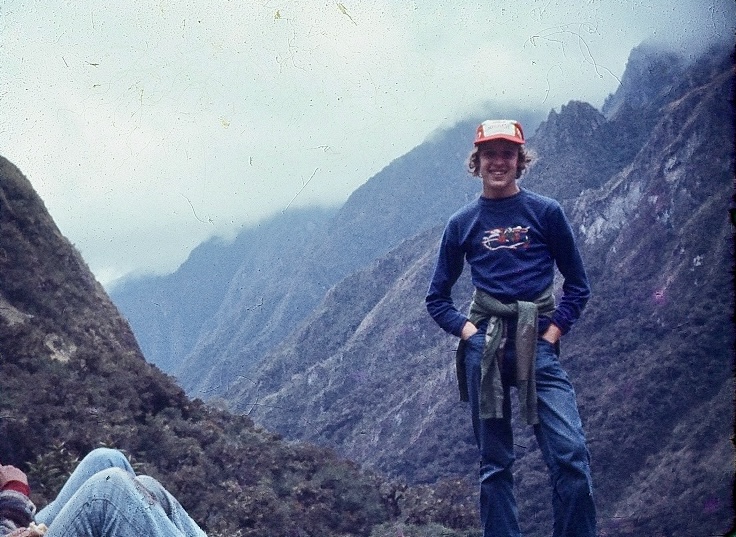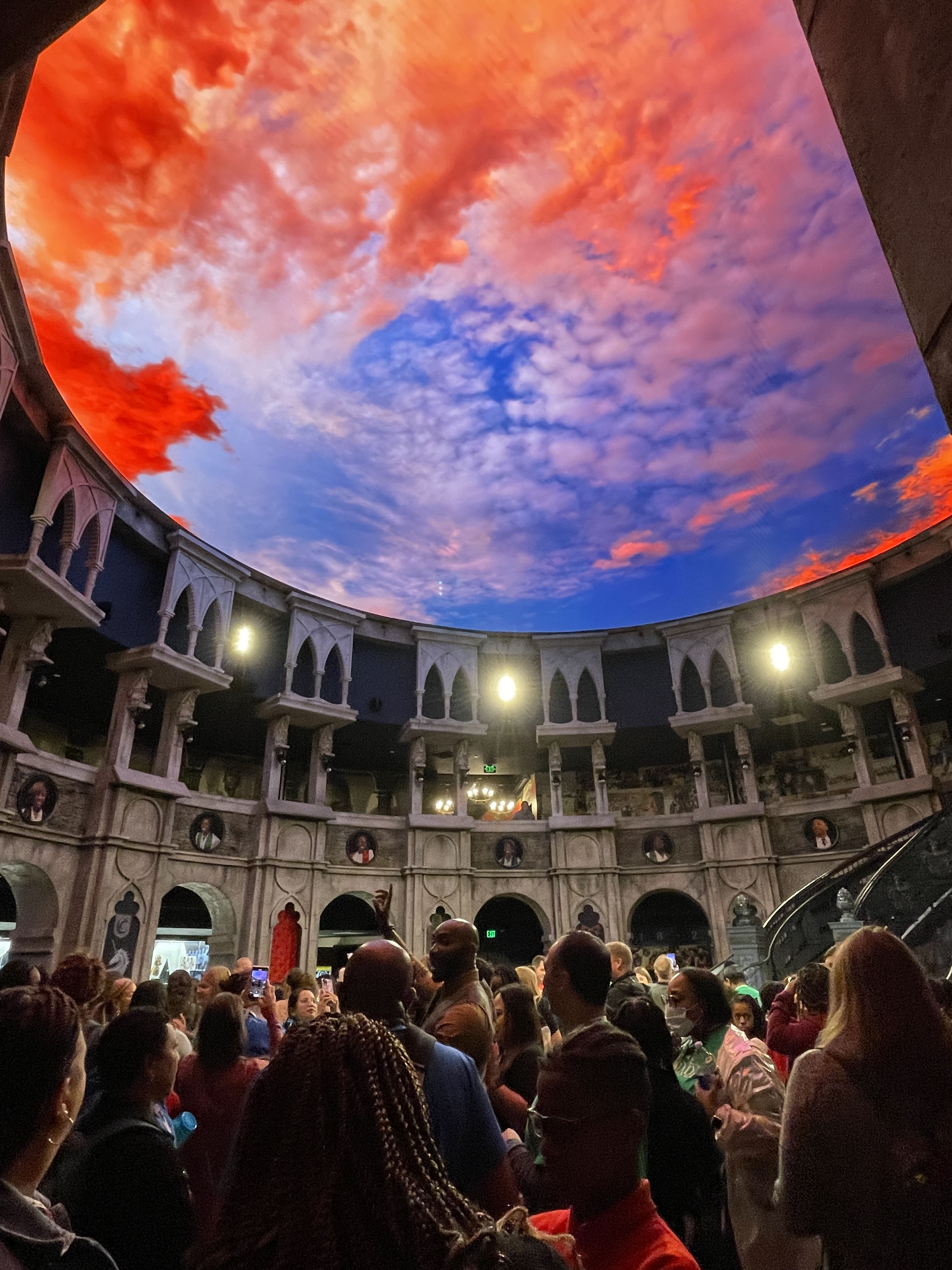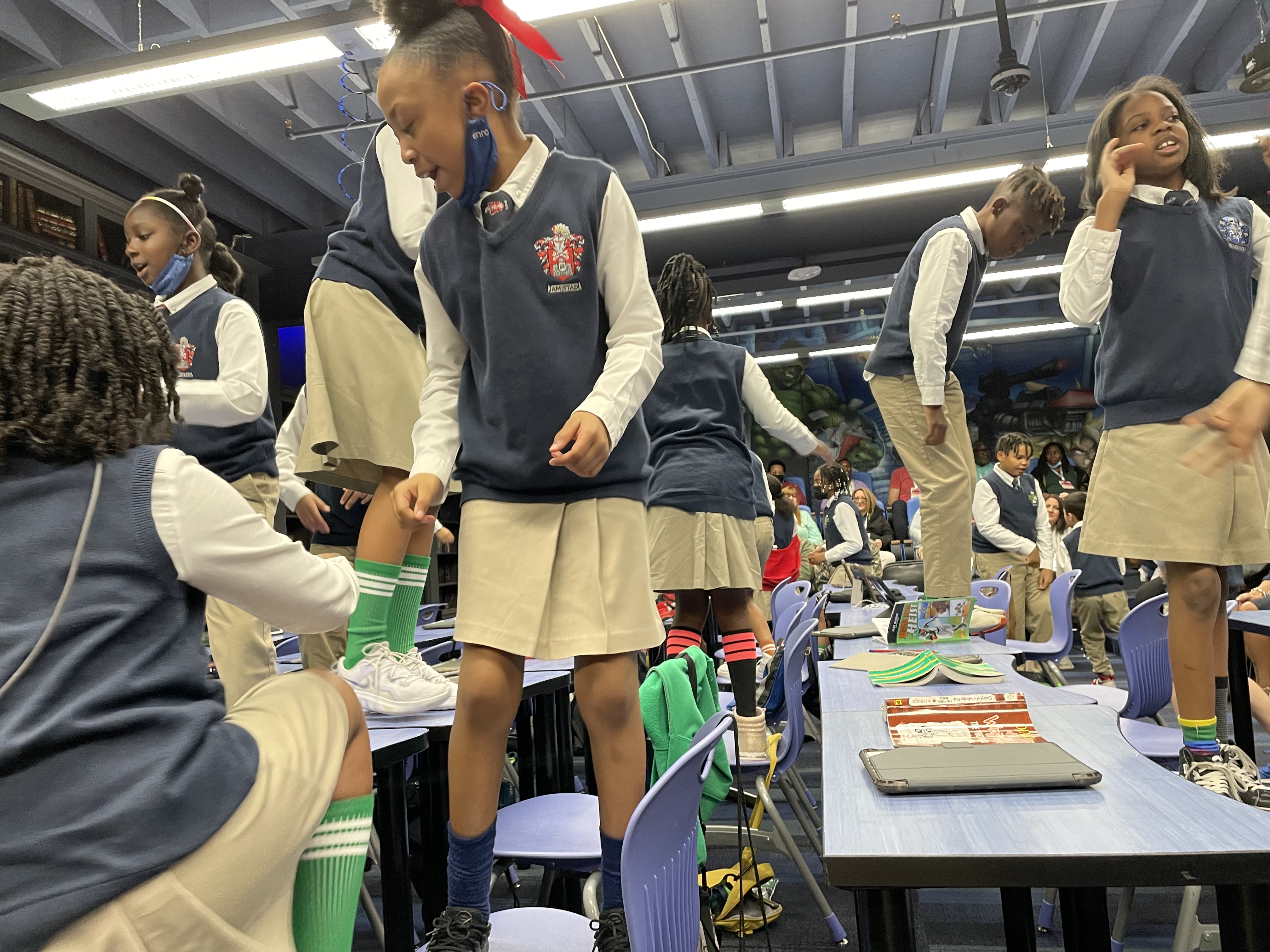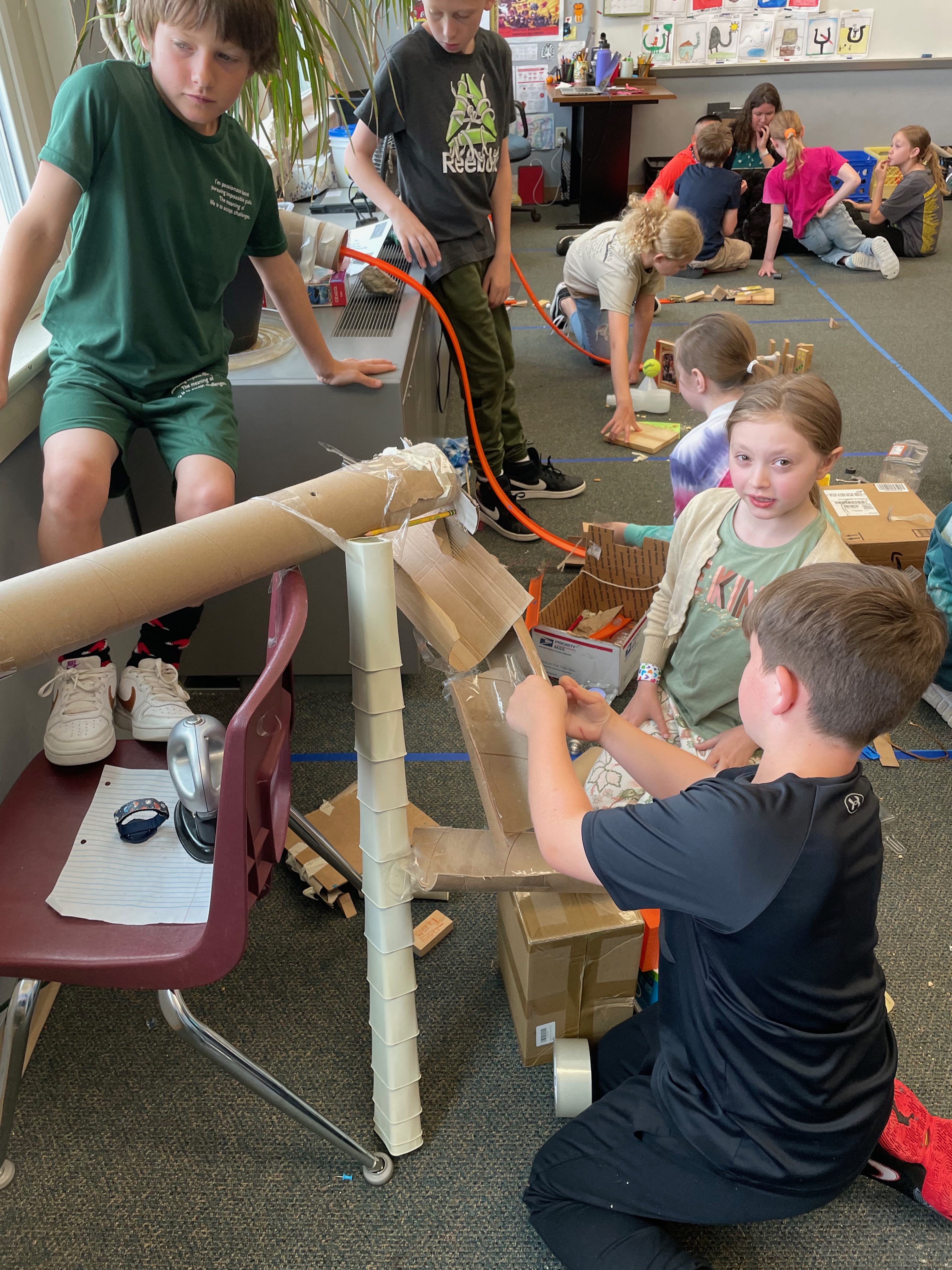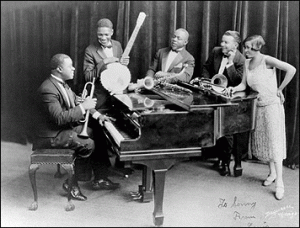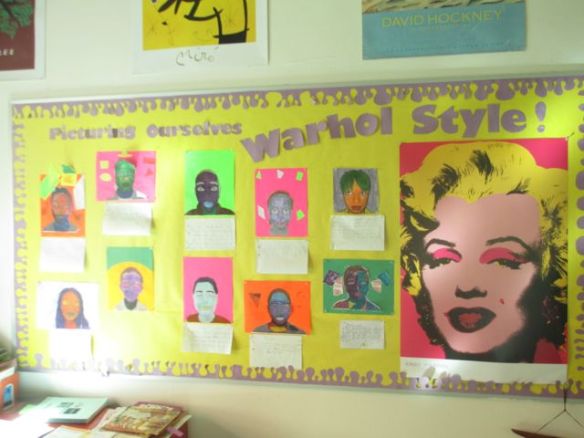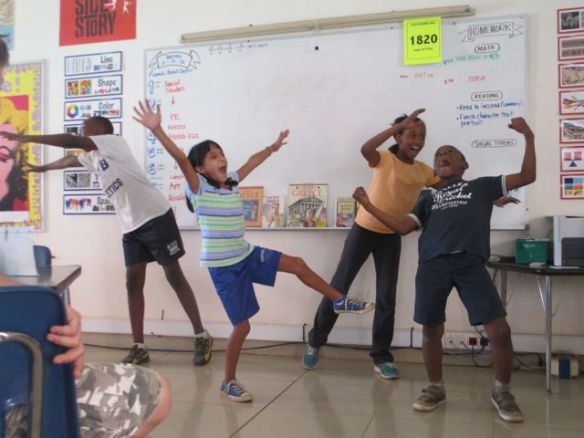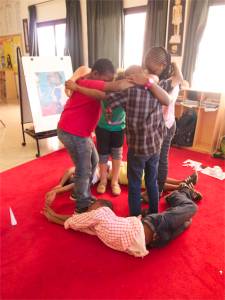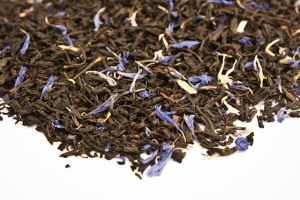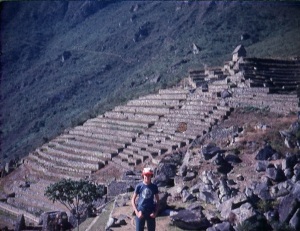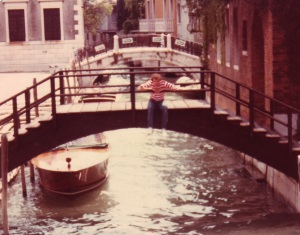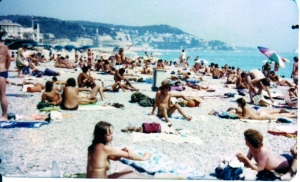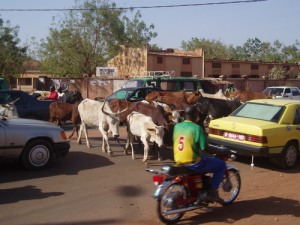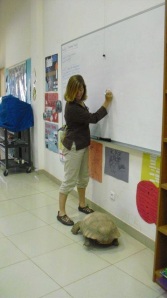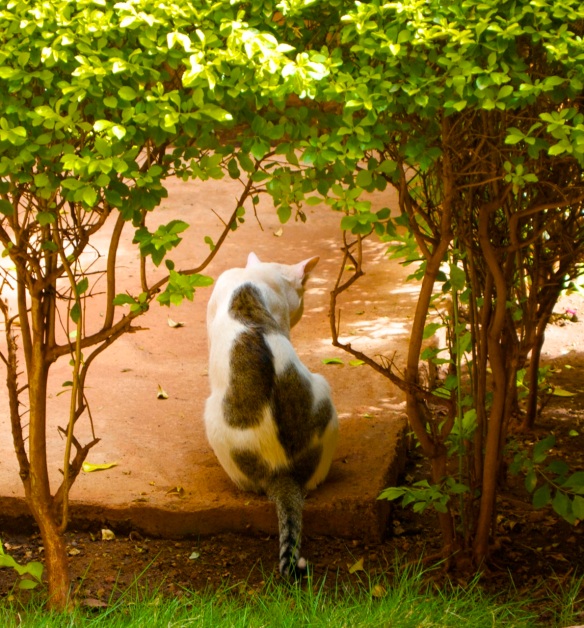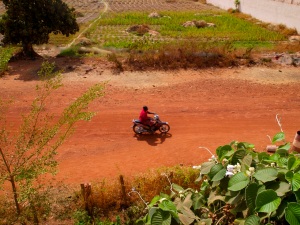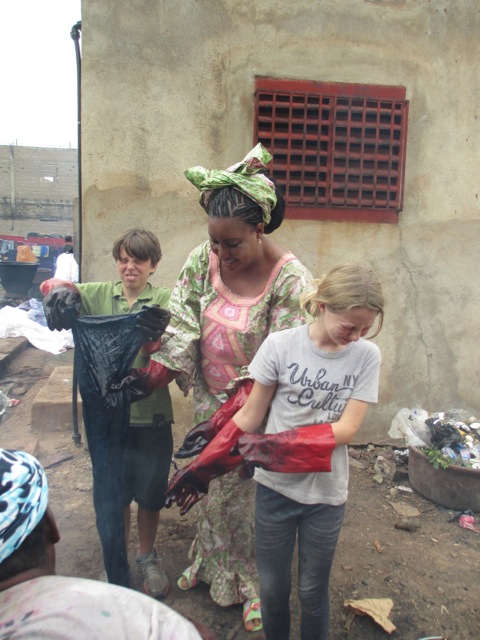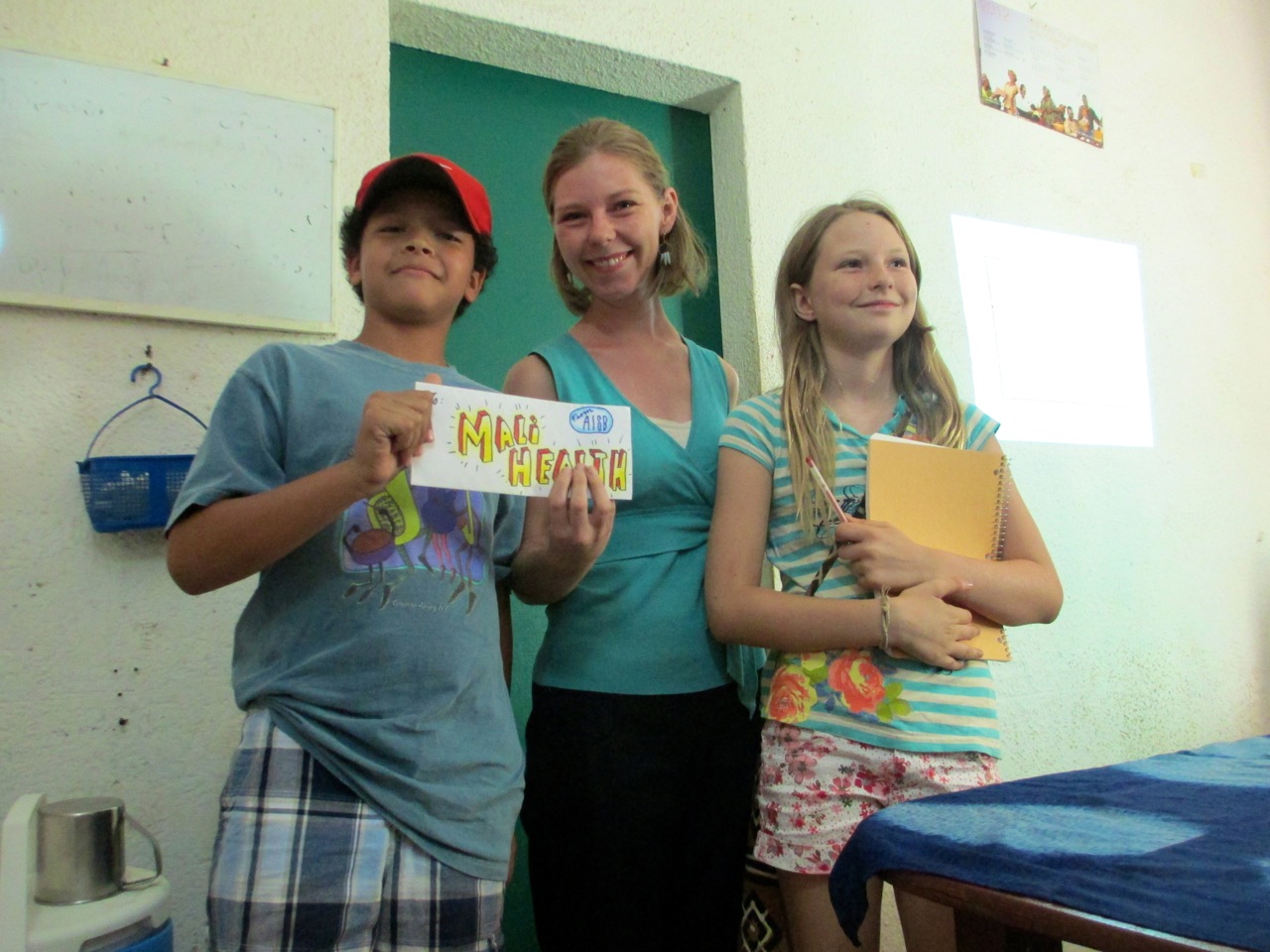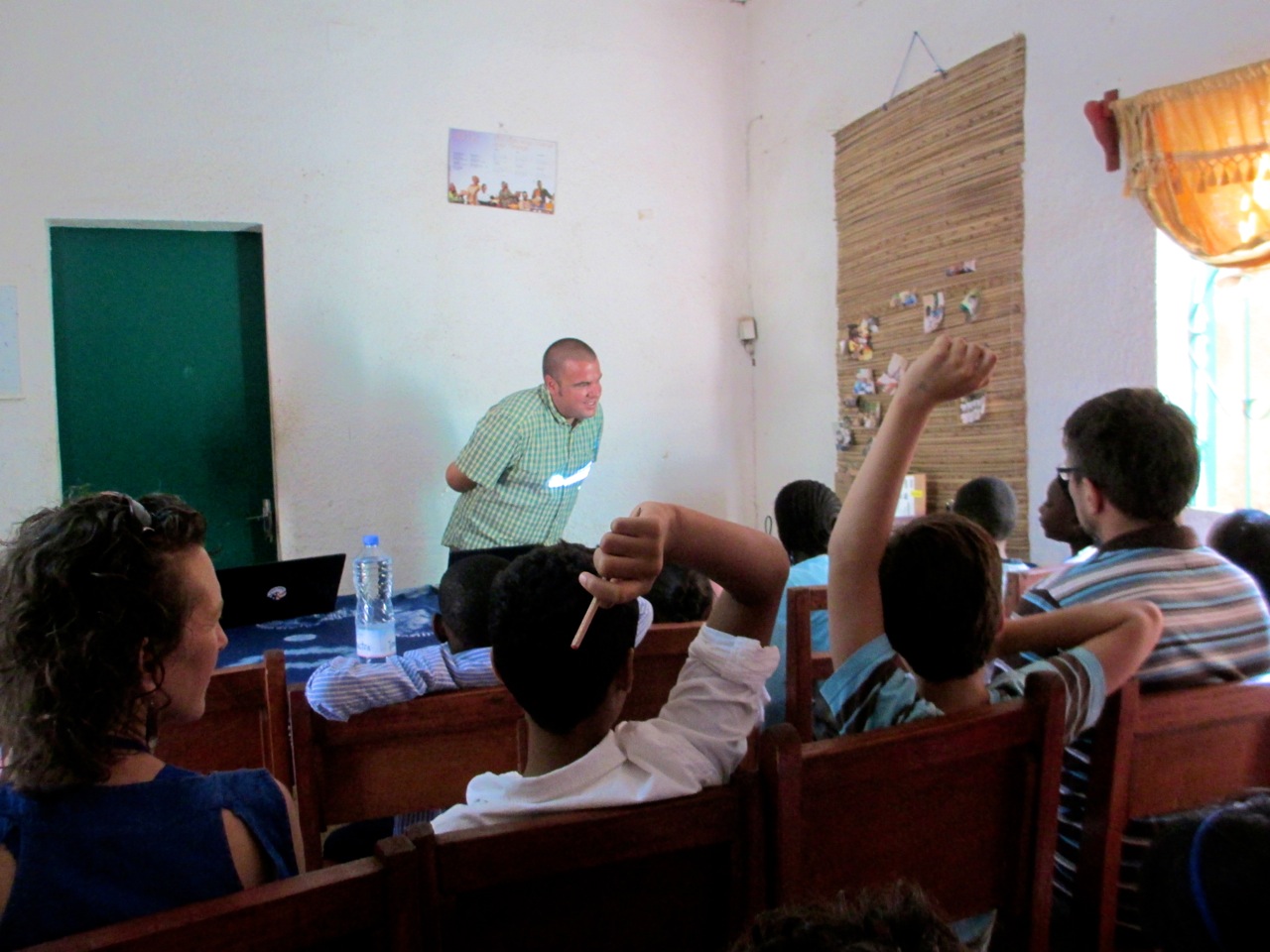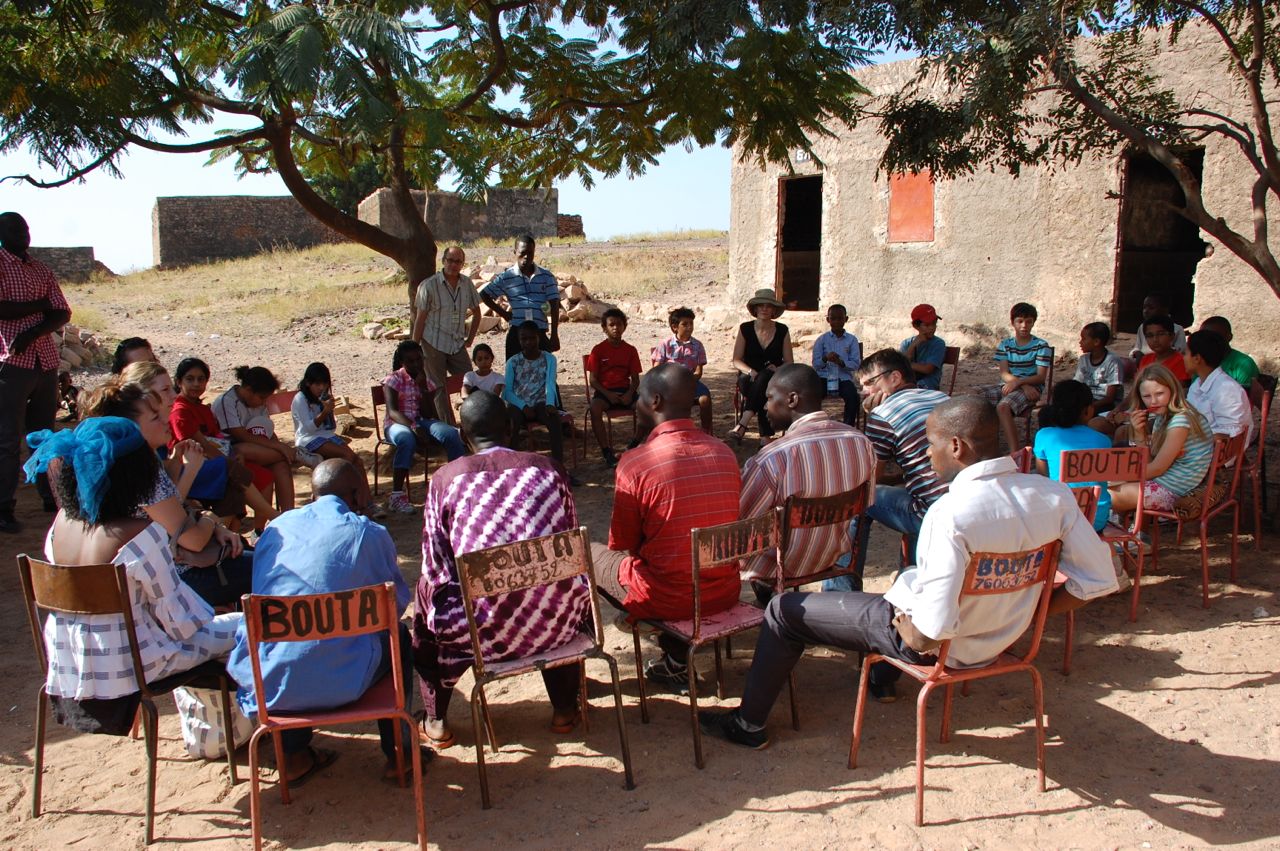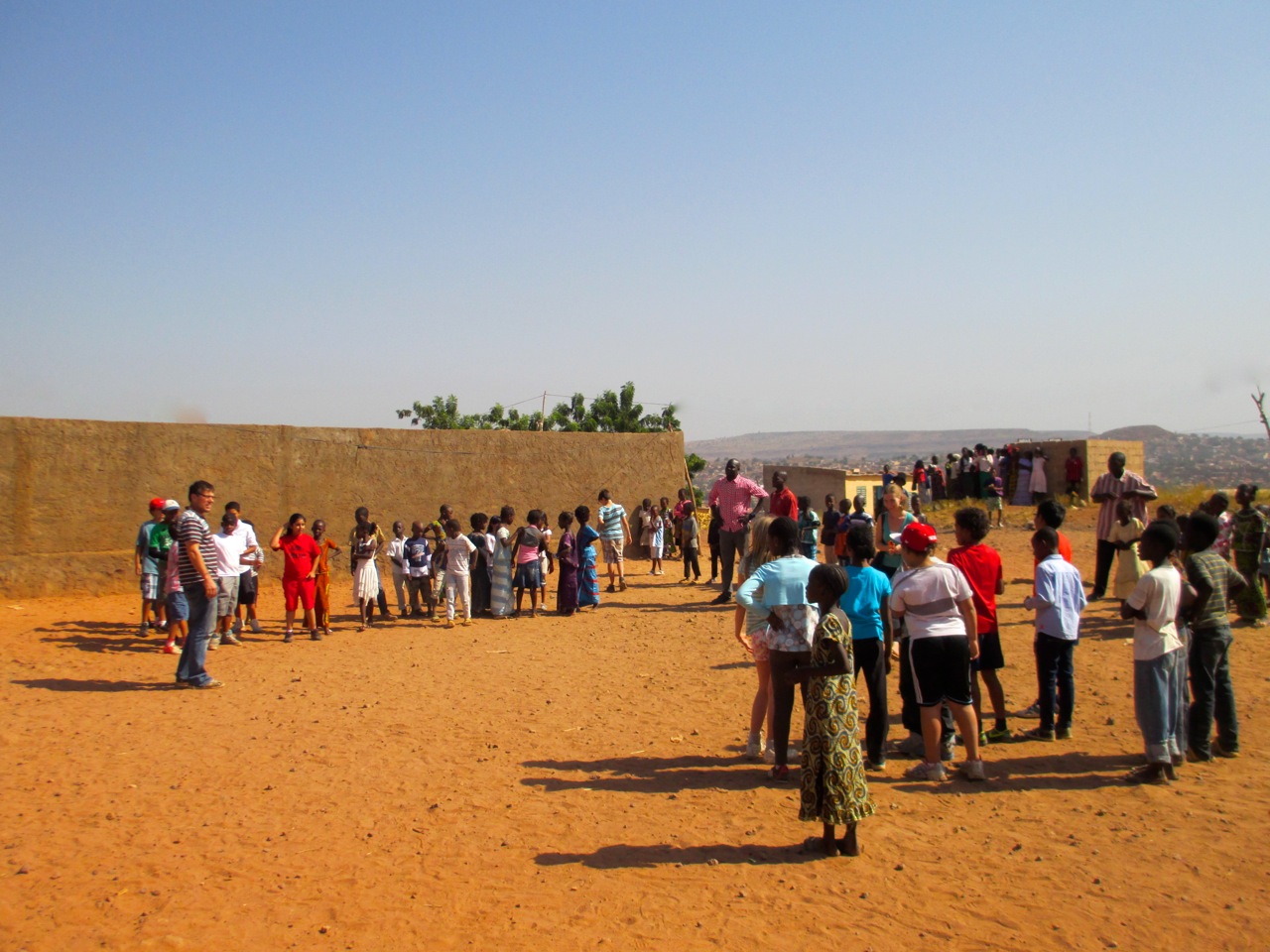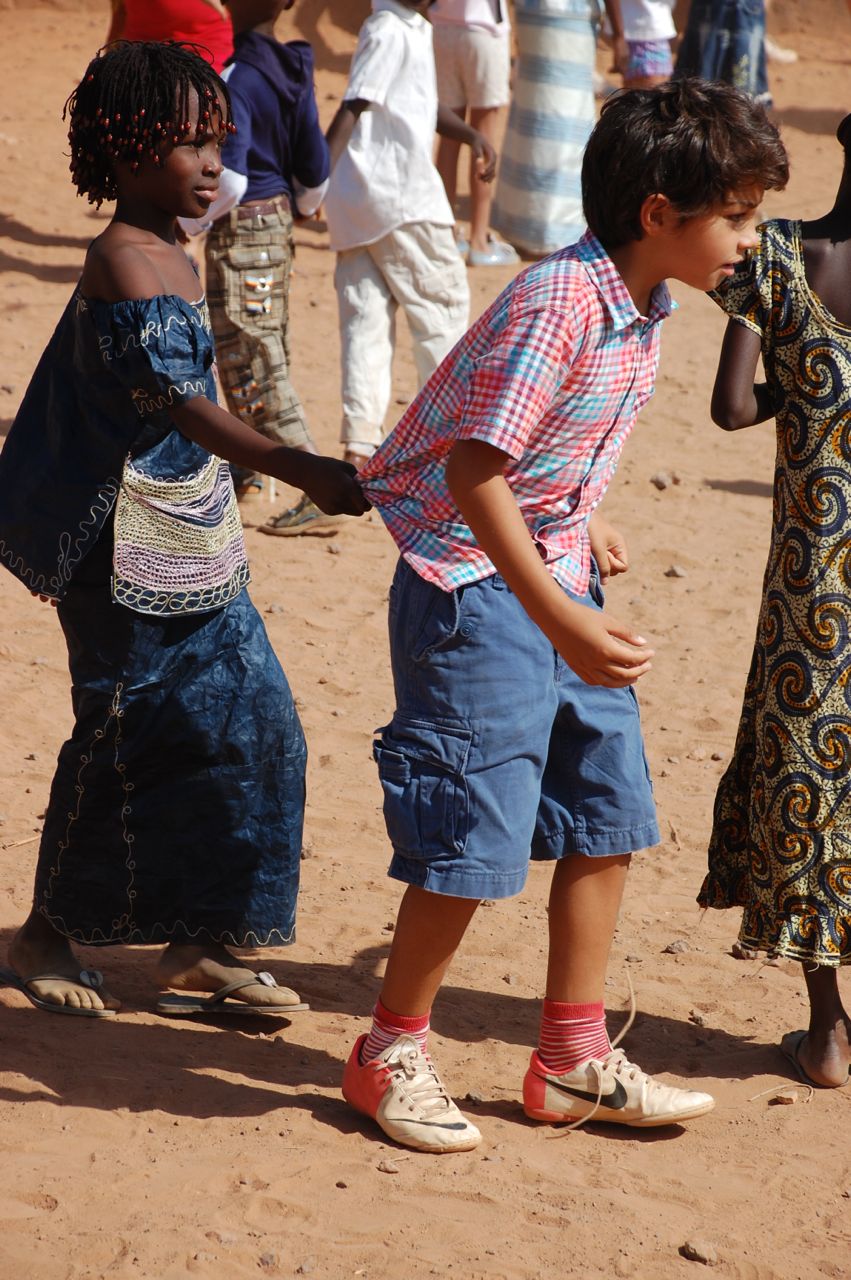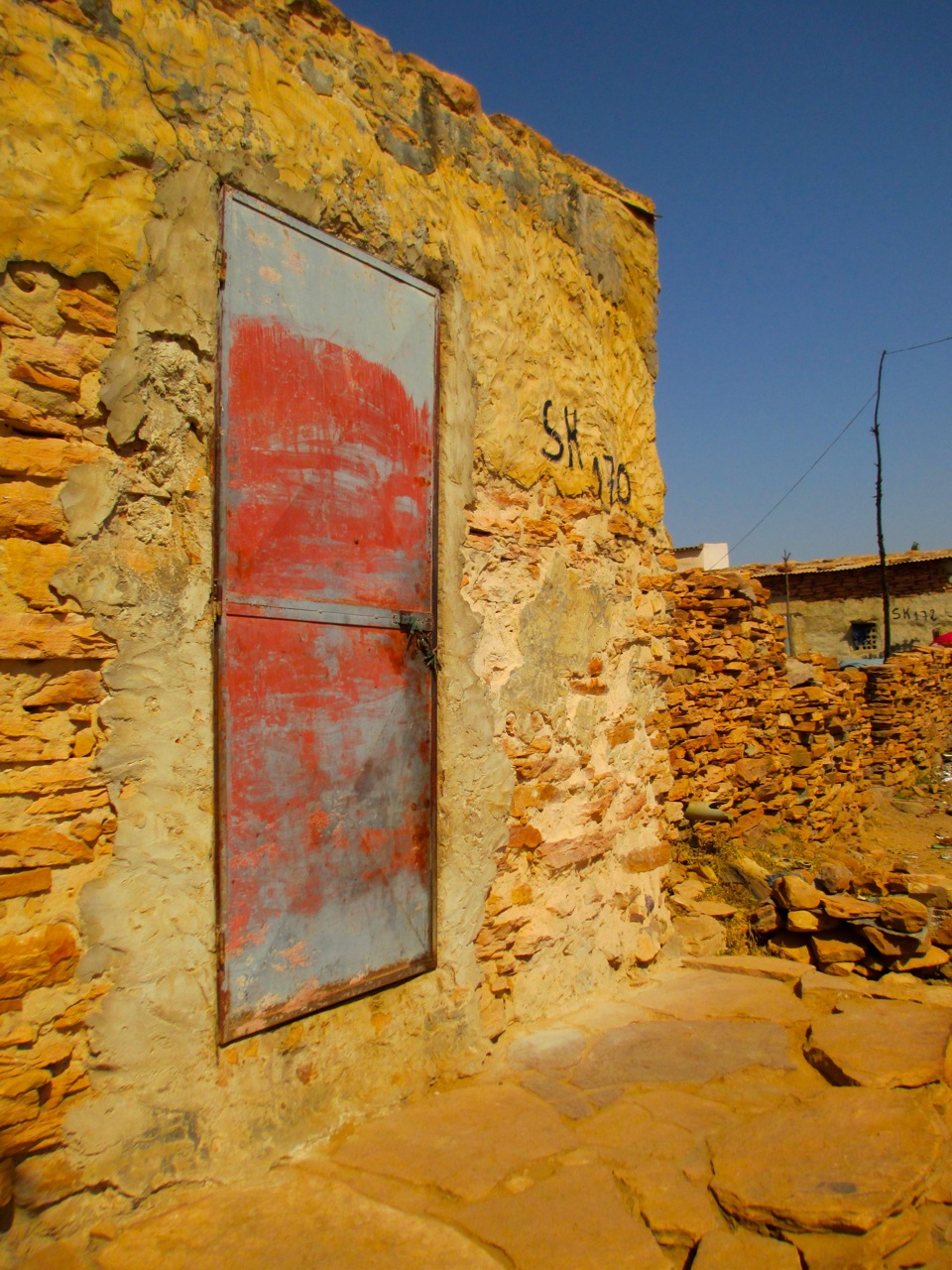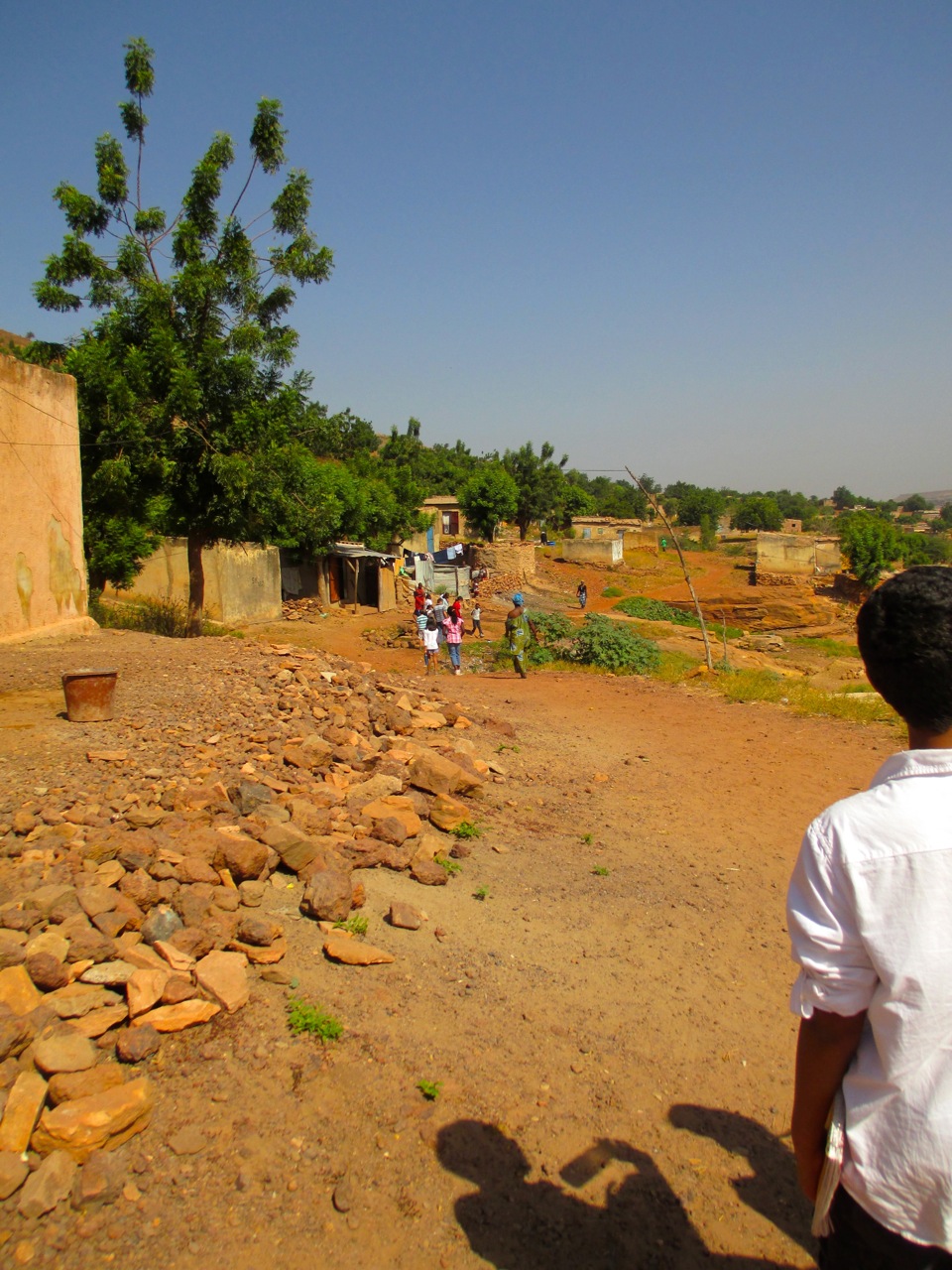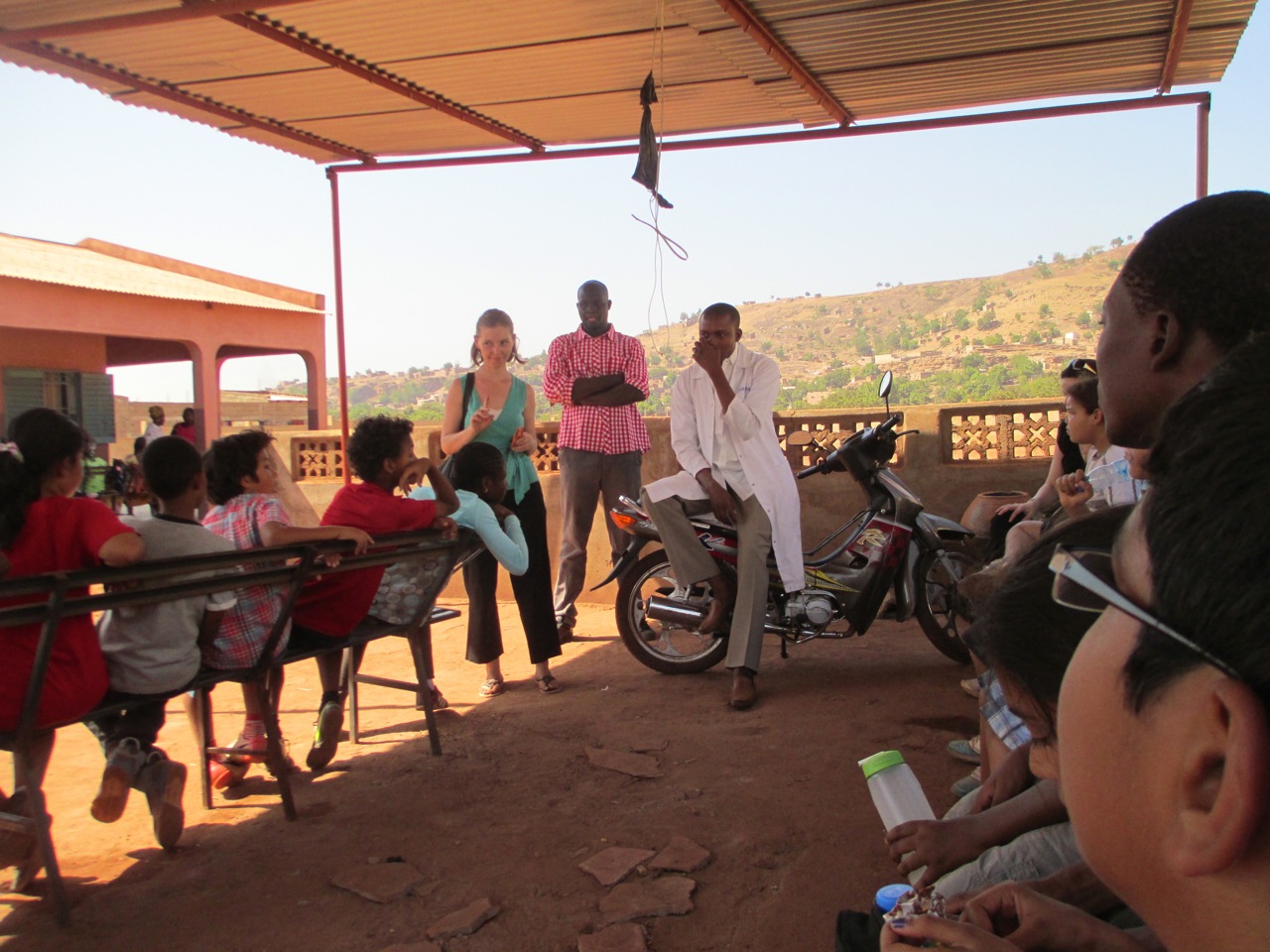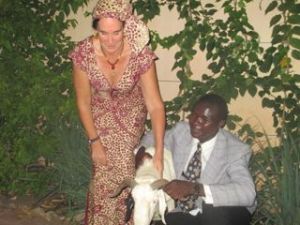Ahhh, Fall Break in Bamako. The frost is on the pumpkin and the leaves are a symphony of autumnal colors. Okay, not really. It’s 90 degrees and sunny and any pumpkins around here are diced and added into a mutton stew.
It hardly seemed like we deserve a weeklong break already but in our Life 2.0, this is how we roll. We decided to join our friends/colleagues Thomas and Cindy and their two kids Kailou (13, and Jamey teaches him) and Jade (10, and I teach her) on a sojourn to Ghana, a quick little two-hour flight on Air Mali—which, I might add, served a full meal. Take that cheapskate airlines in the U.S.!

Boarding on the tarmac…still like this better than sweaty, claustrophobic jetways.
We landed in Accra, Ghana’s capital and a sprawling city that seemed to never end. The main part of the city looked much more modern than Bamako as I noticed traffic lights, a Woolworths, and (drumroll)……the Accra Mall! Well of course we asked our taxi driver to stop there since our shopping options in Bamako are limited to roadside stands selling goat heads or gas, and whatever the Lebanese grocery store owners buy from the Chinese wholesalers.
While technically the Accra Mall is a mall (food court, stores in rows, a massive new SUV parked inside that all the men were looking at, traffic clogged parking lot) the two anchors

Pseudo-mall, Accra, Ghana
were Walmart-style stores that smelled like new plastic and were filled with lots of Chinese imports made of plastic. The rest of the stores, lining two short wings of the mall, didn’t have anything we were interested in–not a pair of Gap khakis or an Aunty Anne’s pretzel place in sight. So we headed out in two rickety taxis toward our first beachfront hotel. Along the way we made a stop at a restaurant for some traditional Ghanaian food. I had Red-Red, which is another take on beans and rice and probably wasn’t a good choice for the long, bumpy ride ahead.
It was an interesting ride. We were tucked into two un-air-conditioned taxis. Francis, driver of the taxi I was in, had the radio turned up full volume to a talk-radio station spoken in Twi, a local language that to me sounds like people arguing. And he kept calling people on his cell phone as he weaved in and out of heavy traffic. Lots of tail-gating too. And did I mention there were no seatbelts?
We drove for an hour or so and it quickly became apparent that this is a super-dooper Christian country. There were roadside churches every couple of feet with names like “He is Coming Apostolic Church of Our Lord and Most Gracious Savior” and “Jesus and His Apostles Continuation Church of the Most Holy Redeemer of Jordan” and so forth. Lots of religious billboards too, advertising things like “7 days of Fasting and Celebration” which

The Savior finally got his PhD.
made me wonder just how much starving people could really party down. And the cars had adhesive letters attached to the rear windows saying things like “I am covered in the blood of Jesus” which we saw twice and actually both drivers appeared dry. We also saw “Dr. Jesus” which of course made me wonder how the Savior fairly gets a PhD since he would obviously be able to snap his fingers and a dissertation would just appear.
But most religiously striking of all were the names of the gazillion little booth-type stores lining the roads for almost every inch of roadway. No matter what they sold or what service they performed, they always worked a Jesus-y type of feel in there somehow. For example, there was “God is King Razor Wire Company” that featured a skull and crossbones logo. Also: My Hands are Blessed Sewing Shop, Bride of Christ Aluminum Works, Jesus is Lord Agro-Chemical, God Did It All Fashion Centre, Blood of Jesus Electricals, and I Shall Not Die Motors. If the road didn’t turn into a series of canyons I probably could have recorded more of these names, but the taxi was bobbing up and down like a buoy so I mostly kept my eyes closed.
An hour later finally arrived in pitch blackness at Big Milly’s Backyard in Kokrobite Beach, where we would spend our first two nights.

Relax, oh tourists. But not with drugs.
It’s a walled compound that backs up to a working beach, and includes a big outdoor bar, an elevated restaurant overlooking the crashing waves, and then a series of individual structures containing one or two rooms. Our place had a quaint front porch where we could sit and relax, but the room itself was tiny—really just room enough for the full-sized bed and a chair. There was a little AC unit that didn’t work well the first night but did the

Big Milly’s bar, front and center.
second night. The bathroom was a closet-sized alcove with a toilet and showerhead (no sink) and no door—just a see-through gauze curtain that was not an effective sound stopper, if you know what I mean. I should probably say that the room cost all of $25 and Big Milly’s caters to backpackers, so we knew not to expect Jacuzzi tubs and 1000 thread count sheets (they were tye-dyed here, by the way).
The next day was marvelously sunny and we were excited to hit the beach after being in landlocked Mali for the last two and a half months. I read a little notice on the back of the door that said the beach was safe to walk

…or you’ll be stabbed!
and the villagers were friendly “as long as you brought nothing with you.” Then it said, “For more details ask the receptionist.” So I headed to the reception building and asked the young Ghanaian man about the beach. Here’s how it went down:
Me: Can I bring my camera to the beach?
Ghanaian: No (said without looking up)
Me: Will it get stolen?
G: Yes. (still not looking up and speaking in a monotone voice)
Me: Really…
G: They will mug you. (said matter-of-factly)
Me: With weapons?
G: Knives. So is your room okay?

Jamey braves the beach.
So my parade was rained on a bit since I hadn’t factored in a knifing during this vacation. We did frolic in the water, without anything but ourselves and our bathing suits, and not one stabbing occurred. It’s a working beach so there was always something to see-the wooden boats coming ashore with nets full of fish and lobster and ladies carrying baskets of stuff on their head, like baggies of water to drink or a heaping basket of bras in a variety of delightful colors and patterns, such as camouflage.
We did have a fantastic dinner at the open-air restaurant overlooking the crime-ridden beach—a heap of fresh lobster that really just melted in your mouth. It made us forget all about the potential bodily harm that could happen just a few meters away.

Sit down, you’re rockin’ the boat..
All-in-all Big Milly’s had a weird vibe to it, as budget, backpacker-type places often do. There were two English dudes motorcycling across Africa who worked on their bikes right in front of our little house the whole time we were there. There was a serious-looking dreadlocked blonde gal lounging around who may or may not have “worked” there. There were locals playing what looked like speed checkers (not sure that’s a real

Quick pic of me and a boat, then back to the safety of Big Milly’s.
game) around the bar. There were signs saying “Smoking Area – No Marijuana – Cigarettes Only). When I was chatting with the receptionist when changing money, she told me she didn’t like Obama because he “legalized homosexuality.” And when Cindy and Thomas turned in some dirty clothes to be laundered, they came back still dirty, but folded. We were ready for the next hotel.
Off to Green Turtle Lodge
On Day 3 we had arranged for our very own vehicle to take us on the looong journey to the Green Turtle Lodge in Akwinaa Beach (with a couple of sightseeing trips in between), far to the west about 6 hours or more.

Here we are, still in the “this is going to be so much fun to ride in” phase.
We were riding in a tro tro, the Ghanaian term for any public transport bigger than a regular taxi, and it’s usually a cargo van. Ours pulled in an hour late at 9 AM sporting a brilliant orange-red paint job over it’s rickety, rusting frame–what my students back home would have called a “hooptie” or what we might call a vehicle that we would prefer to take a picture of rather than ride in. While Ghana is an English speaking country, the driver didn’t speak it very well, nor did the two guys accompanying him whose roles we didn’t understand. But he assured us he knew where he was going, and off we went. In the exact opposite direction of where we should have been going.
Thirty minutes later we determined we were heading due east rather than west, and the driver swore we were going to Lake Volta in eastern Ghana, even though we had shown him on the map that we wanted to go to the Green Turtle Lodge in far western Ghana. The three guys (whom I’ll call Clueless Driver, Bitchy Co-pilot, and Pee-Guy) were perturbed but turned the tro tro around and back we headed to where we began, now a full two hours behind schedule. The tro tro was un-air conditioned and the windows rattled and the seats were tattered and not very cushiony and the traffic fumes filled the whole inside with a diesel-ish smelling odor. I was trying to imagine a worse form of transportation–maybe a razor blade-covered surfboard? A bike made out of poison ivy and King Cobras? A canoe made of human waste? Our tro tro was still worse.

Cape Coast palace, where tens of thousands of kidnapped Africans were held before being shipped off to a life of slavery.
After a couple of hours we reached Cape Coast, a somewhat picturesque seaside town that features the Cape Coast Palace, a 200-some year old structure that the Obamas visited a couple of years ago. It was originally the place where tens of thousands kidnapped Africans were brought, processed (e.g. branded), and sent through the “Door of No Return” to be herded onto ships for a grueling overseas journey to slavery–if they even survived the voyage. We walked deep underneath the structure where I immediately stumbled into a small water-filled trench, originally where human waste would have flowed. I tried to imagine what was going through the minds of these prisoners as hundreds of them were crowded into these dark, underground dungeons with not a breath of fresh air and no idea of what their future held. I couldn’t get out of there fast enough.
On the road again, we noticed Bitchy Co-pilot getting more and more irritated, turning around occasionally to say (I think) “This is very far!” or maybe, “I want to stab you” or whatever. We kept restating the directions and the destination, naming the towns we would pass through and exactly how many kilometers between each. Clueless Driver kept pulling over and asking random people on the road if they knew where Green Turtle Lodge was—even though we were hours away and it was a tiny remote hotel off the beaten track. Every time we stopped Pee Guy would hop out and urinate a few feet from the tro tro, with his back to us but still…eew. Seriously, I can appreciate cultural differences and all, but peeing 2 feet from a van full of strangers is just tacky unless you travel back through time to medieval days. It was probably even tacky then.

Roadside scenery
Now this particular routine continued for the next EIGHT hours, with Clueless, Bitchy, and Pee getting madder and madder. The roads turned bumpier, then it got dark and the tro tro windows were so filthy that it was like driving through pea soup fog (there was no wiper fluid, naturally). Just when it seemed that things couldn’t get worse, we went through a village with 5 foot wide mud roads that was having a giant street celebration complete with throngs of people and smoky air and a brass band (I’m totally serious…a brass band in remote Ghana) and they were all reaching into the windows and screaming and chanting. I thought C, B, and P were going to lose it right there and plow through the crowd at full speed.
After they asked yet another random guy on the road about the lodge, we were directed down another pitch black, muddy, rutted road that eventually turned into a single path with thick jungle on both sides. And was it ever pitch black. Tar black. Ink black. The muddy path was full of deep gashes and sharp ridges, and that old tro tro creaked and swayed and hit bottom over and over. Between the angry crew and the Little House on the Prairie style road my stress barometer was reaching a new high. When Bitchy blurted out something about how stupid this all was, I finally engaged him:
Me (in a near scream): WHAT DO YOU WANT US TO DO?!? WE DON’T KNOW WHERE WE ARE. YOU DON’T KNOW WHERE WE ARE. QUIT TALKING!!
Bitchy (screamy tone): Poot da mooney on top, poot da mooney on top!
Me: Poot da what?!?
Bitchy: Poot da mooney on top, poot da mooney on top!
Me: What does that even mean?
Bitchy: Poot da mooney on top, poot da mooney on top!
Me: I don’t know what you are saying. Turn around.
Bitchy: Poot da mooney on top, poot da mooney on top!
At this point Pee-Guy grabbed my hand and shook it saying, “It’s okay, it’s okay.” As in, ignore the freak in the front. Thankfully a sign for the Green Turtle lodge appeared in the headlightss and we were there–after being in that ratty tro tro from 9 AM to 7 PM. We decided to give the crabby, clueless trio an extra $50 (which apparently is what “put the money on top” means) but of course Bitchy demanded another $10, to which we just said “GO AWAY” and dismissed him with a flick of the hand, just like in the movies.
Finally at the Green Turtle

Empty beach for miles and miles…
Once our tro tro disappeared into the darkness (thank God), we were led by a tall, be-robed man to our beachfront house at the end of the Green Turtle property. We literally walked along the beach to get there. It was dark but the moon was bright and made the coconut palm fronds sparkle in the ocean breeze. The sound of those waves crashing practically drowned out our conversations. The beach house was brilliant—a long, covered front porch along the whole front façade, 2 giant bedrooms at each end with big windows facing the beach (no glass, just a screen) and a steady ocean breeze blowing in,

Our beach home away from home
all solar powered lights and fans, pebbly mosaic floors, and a big bathroom with a shower surrounded by a rock wall. I was thinking that this might have been worth the last ten hours of torture. Well, at least until I saw the composting toilet, which looks like a toilet until you open the lid and peer down into the dark hole where all of the stuff just drops onto dirt. That part wasn’t especially pleasant, especially after a couple of days.

Made me wanna drink more…
All of us shared the beach house, formerly the home of the British couple (and their two kids) who ran the place. Apparently from the scuttlebutt we heard at the bar, this couple had put the place up for sale for 300,000 Euros and flown the coop a year ago to return to Britain. They still own the place but left a manager in charge along with a Ghanaian staff of 20 or so folks. It was evident that without the owners there to attend to the details, well, the details just weren’t attended to. Don’t get me wrong, it was still a magical place—miles of beach without a hotel, house, or person in sight (a few dogs and goats and an occasional sea turtle though), individual cabins/huts made of local materials and powered only by solar energy, the best bar ever featuring a surfboard with the Savior painted on it saying “Jesus Loves Cocktails,” gazebos on the beach where you could eat your meals,

Interpretive dance or a muscle spasm, can’t remember which I was doing.
oceanside hammocks, etc. But as we had to remember with the last place, this was far off the beaten path and budget priced–our house for 6 people was a whopping $50/night. I’ve paid more than that for a bottle of gin.
When we awoke the next morning it was raining, and that would normally bum me out. But it just felt so perfect! We just sat on the porch and chatted, watching the rain hit the slate blue ocean. We ran in the

even looks good in the rain…
rain to have breakfast in the bar–French toast with grilled plantains. The rain eventually stopped and we walked a mile down the beach to a seaside shantytown village called Akwidaa where their shacks were no more than 10 feet from the ocean, and where a crowd of local kids (some of them butt naked, and not just the little kids) gathered to watch these crazy Americans. Obviously not too many tourists made it to this faraway place and I kind of liked that. Of course just when I thought I was at the edge of the world in a place untouched by time we passed a stand selling Coke and Twix bars. And then one of the kids started rapping some Jay Z song.

Me with the village people
Three kids followed us all the way back to Green Turtle, offering to climb a palm and get us some coconuts. We finally said okay, up the palm they went, and minutes later we were sipping fresh coconut milk and eating fresh coconut meat. We gave them a couple of dollars and they left. Kailou, Jade, and I hit the beach again to build a sand castle. Then it soon became clear that our coconut providers had returned to the village and spread

Our coconut hunters
the word that the rich Americans were doling out big bucks! Come one, come all! Lots of kids came, surrounding us and our castle. One five-year-old even had a machete (thankfully for coconut chopping rather than tourist chopping). They kept asking for money and I found the best way to say no was just to sing show tunes loudly. I got through the better part of the Grease songbook before they gave up and walked away. “Those suh-uh-mer n-i-i-i-i-i-i-ghts…tell me more, tell me mo-oh-ore.” I love you Olivia Newton John. Seriously, this could be a great tactic for the army to use to deter enemies.
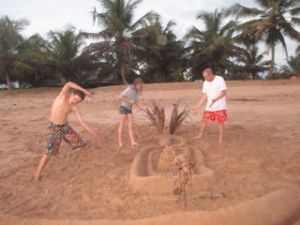
Sand castles and show tunes.
That night we had a delicious meal of grilled fish, chicken, and lobster in our own little gazebo smack dab on the beach. We had a lantern illuminating our table, and the only other light was the almost full moon. No more machete kids, just waves crashing on the beach. After eating we walked along the shore looking for sea turtles laying eggs, and it’s amazing how old shoes, food containers, and various other things that belong in a trash bin actually look like turtles from a distance. We just pretended they were.

The village people head back after enduring hours of show tunes.
Toward Kumasi
The next morning we had arranged for a better mode of transportation to take us on what we thought was a 4-hour drive north to Kumasi, the heart of the Ashanti culture in Ghana. The Ashanti are legendary warriors who kept the invading British at bay longer than any other group in Ghana. They are also known for their beautiful crafts and their Kente cloth, and are still “ruled” by a king who wears the coolest-looking outfits ever that they believe repel bullets, even though they are made of cloth and feathers and such.
Obviously a crippled donkey would be a better mode of transport than that awful tro tro we endured. Our ride this time was an upgraded van of the last decade without visible rust and still possessing an original paint job with a slight sheen. The driver (whom I’ll call Hoarse Guy) and his partner (Door Opener) seemed nice enough though barely spoke and/or understood English. The bumpy path that seemed to be such a nightmare two nights prior wasn’t as bad during the day in a vehicle with shocks. We were soon zipping down a highway and even with the windows open it was pleasant enough. I could handle four hours of this.
Except it was eight hours. And seven hours of that was on a deteriorating blacktop road that was pockmarked with potholes 8 or 10 inches deep. Hoarse Guy, who spoke with a gaspy, airy voice that was probably difficult to understand in any language, was also thinking he was Speed Racer. He would roar 70 MPH down this awful road, swerving to avoid potholes, driving on the wrong side of the road into approaching traffic, driving onto the rocky unpaved shoulder, well, you get the general idea. The only thing that could be worse is if some weird moth-like creature landed on my foot while we were riding along, bit me, and drew blood. Okay, that happened too! As Hoarse Guy started passing a giant truck on a hill, I had enough. I shouted from my back seat that he needed to slow down and drive more carefully or I was getting out and not paying him a dime. He whisper-talked something and waved his hand, and after that he was less of a danger, but still swerving all over the road.
The best parts were when we followed a giganto truck spewing diesel fumes, and the smoke filled our van, mixing with the dust that was flying through the air too (I had to wipe off my iPad every 30 minutes or so to remove the dusty film). I asked him to turn on the AC so we rolled up the windows and sat in a blistering hot tomb for 30 minutes until we decided the AC didn’t work so well. Hello diesel and dust and various other smells that wafted in (plastic burning, campfire smoke, animal poo, and flowers for a just brief second. I have been on a public bus in the wilds of Peru, in a crazy taxi in crazy Cairo, Egypt, and in a pickup truck on a steep and rocky mountain road in northern Thailand, but this particular trip definitely topped the list of the worst rides ever. I was relieved that at least the two person crew wasn’t belligerent like the last bunch, with hoarse guy remaining silent (or at least inaudible) and Door Opener guy just opening the door for us whenever we stopped.

Our lunch pit stop, where the food smelled like manure and wet cows.
Oh yeah, the pit stop! How could I forget? We asked if he could stop at a restaurant around lunchtime and Hoarse Guy was quite perplexed. He would say that we were approaching a town with restaurants and then we we got to an area that looked sort of like a town we would say, “So is this the town?” And he would whisper-talk, “No, we passed it already.” Then we would repeat our request to eat at a restaurant. This went on for some time. Finally we saw a sign for “The Royal Hotel and Restaurant” and made him pull over. This open air restaurant had a TV blaring with a Chinese kung fu movie. The hostess said they only had rice and foo foo with either fish or goat. I was sitting this one out as it all had garlic in it (my deadly allergy) and my stomach was tied in knots from the ride. When the food came it smelled like farm odors, maybe sweaty and/or butchered livestock and manure. Mmmm mmmm good.
We finally arrived in the town of Kumasi at rush hour, though we didn’t know where our hotel was located. After some pointless driving around which we certainly were not in the mood for, I noticed a large hotel that could be a landmark. Thomas found it on the map, was quickly able to see where we were, and guided Hoarse Guy to our place, the Kumasi Catering Guesthouse.
In Kumasi

Our guesthouse unit, nestled in a garden.
I liked this place the second we pulled in. It was a walled, leafy complex with little bungalows nestled into shady gardens. The room was comfortable with sweet views into garden areas and……it had a TV, cold AC, and free wifi! As much as I bitch about technology ruining my life, these bits of technology made me very happy at this moment. We sprawled on the bed letting the cold air fill the room while we read through a weeks’ worth of Facebook postings and drank icy Cokes. The Internet was fast as lightning, a luxury we don’t have in Bamako, so we downloaded things like crazy, AND watched YouTube clips without any any buffering. Ah, the simple things in life can be so satisfying. That evening we walked to Vic Baboos restaurant where they had American, Chinese, or Indian food. I opted for sweet and sour chicken and a really large Ghanaian beer that took the edge off quickly.
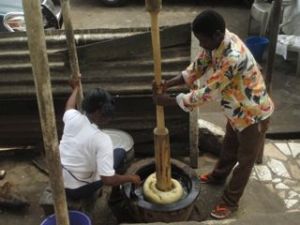
Making foo foo…mashed up casava (and fingers if the pounder isn’t careful)
The next day we headed out in two taxis to the Ashanti King’s palace, a quick five minute drive. But somehow our taxis became separated and Thomas, Jamey, and I were dropped off in a spot where the others were not waiting. Without phones we had no choice but to wait around, and after 20 minutes we found the others who had been dropped off at another entrance. The palace was a colonial style house that was the former residence of the king—he now had a sassy modern home just behind that looked like a house you would see in a basic gated community in the U.S. But the old place was cool—lots of history and life-sized wax figures here and there that would freak us out every time we walked in a room.

Eyes are the window to our soul, and this dude’s soul is wacked out!
Next we headed off in two taxis to the Cultural Center to visit the Jubilee museum and have lunch. Another 5 minute ride, but my taxi with Cindy and Kailou arrived and the others didn’t. Surely they were just caught in traffic and would be pulling up any second. An hour later, just as we were going to call the American Embassy and report a kidnapping, they pulled up. Turns out their driver took them to Jubilee military park on the outskirts of town where they encountered a big parade and lots of traffic.
We blew off the museum in the interest of time and had lunch, then walked to find the famous “Okomfo Anokye sword,” a sword that has supposedly been in the ground for 300 years that many have tried to pull out (including, supposedly, Mohammad Ali).

C’mon, pull out the sword and ruin a centuries old kingdom. Or just drink some schnapps.
If you do pull it out the entire Ashanti kingdom is supposed to collapse, so I’m guessing they aren’t rooting for anyone to be successful. It was bizarrely located in a hutlike structure on the grounds of a hospital. In order to get there we had to pass through the hospital mortuary area and guys pushing carts with metal domes over them and bodies underneath. We paid our $1.50 to get in the hut and sure enough, inside there was a little wall surrounding a small pit in which a sword handle protruded, and empty bottles of schnapps laying around it. Not sure what the Ashanti-schnapps connection is, but we also read that you can get an audience with the current Ashanti king if you bring along a bottle of schnapps. At least we now he has fresh pepperminty breath.
Our final stop was to be a hat museum, a private collection of some 2000 hats from around the world. This time our two taxis stayed together and arrived together…success at last! And the hat museum had closed a year earlier. So it was back to the guesthouse for more TV, Internet, cool AC, and icy cold Coke (I wasn’t complaining). We again had dinner at Vic Baboos (though we did hike around looking for other restaurants) and this time a group of young Americans was clustered at the door. We struck up a conversation and found out they were Peace Corps volunteers in Ghana. They asked us where we were from, and we told them we lived in Mali. “You live in MALI? Wow…..” one replied.
You know when you impress Peace Corps people, the ones who actually live in huts in villages in the middle of nowhere and walk miles to get water from a well, you have earned some street credibility. We told them things in Bamako were fine but I could see they thought we were sooo brave for living in a post-coup nation with Islamist terrorists roaming the northern half of the country. I wanted to tell them how I had to dodge machine gun fire on the way to work every day, and use Kung Fu to keep the terrorists at bay, but I’m not sure I looked so Indiana Jones-ish in my matchy-matchy Original Penguin outfit. They also advised us to take a bus back to Accra rather than a tro tro since the 6 hour ride was REALLY bumpy. Just the outlook we wanted to hear.
The next morning I awoke early and decided to check the bus schedule for the next (and final) day of our trip. As often happens when Googling, I found a blog about traveling in Ghana and how one could fly between Kumasi and Accra. FLY! In just 45 minutes! I checked the website and not only was there availability, but the cost was only 40 bucks a ticket! I ran like the wind to Thomas and Cindy’s room with the news, and even thought they were still in bed they were excited at the prospect of missing out on a 6 hour bumpy bus ride in lieu of a zippy little flight. We decided to leave that afternoon rather than stay in Kumasi another night, so we bought our tickets online and found a beachfront hotel for our final night in Ghana.
Back to Accra

Restaurant at the new hotel, open air and stocked with alcohol.
The flight to Accra was a dream–fast, efficient, and safe, and we were even able to read our iPads and Kindles the entire time, even when taking off and landing. A couple of taxis were waiting to take us to the Alfia African Lodge, a quaint compound of 22 units on the beach. This being the big city, the price was 4 times what we paid for a night at our other budget hotels, but the beach was fun although littered with trash that I just pretended was big seashells. Dinner was to die for, another open air restaurant with ocean views, and super tasty, creative fare. I had mango curry chicken with a dessert of coconut lemon syrup cake (when all 4 words of a dessert make me salivate I know it’s gonna be tasty), washed down with almost a liter of milk stout, a really dark stout made in Accra that almost tastes like beef.

Hotel decor.
Back in our hotel room, which had a view of the ocean if you craned your neck far to the left, we drifted off to sleep with a smile on our face. Then we awoke at 1 AM sweating because the AC had stopped and it felt like we were locked in a metal shipping container in the middle of the Sahara. We tried to turn on the fan, but nothing. And the windows didn’t open. I attempted to call the front desk, but the phone didn’t work. Goodness, had the zombie apocalypse just happened while I was dreaming for the past two hours?
I dressed and started out for the reception area, and found the security guard who informed me that the front desk was closed and would open at 6 AM, and they could help me then. No, no, no I said. We need a new room now, not in 3 hours. “No poss-ee-bull,” he said. I asked him to call the owner. He chuckled. He said he would find help and left, but after 40 minutes I saw him slowly wandering around the compound again, not even thinking about us.

Accra beach with its big, big seashells
I started in again and didn’t let up and he eventually sent me to security guard number 2 who I think was a clone of the first guy, or maybe just the first guy playing another role to confuse me. “Go to sleep for 3 hours he told me, then we fix,” he offered. No, no, no I said again. “I’m going,” he said to me. “Going where?” I asked. I’m going,” he repeated. Was he blowing me off? After a lot of back and forth I figured out that he was trying to say “I’m going to be right back. By now it was 3 AM and we were sitting sweaty in a tomb of a room since going outside meant risking malaria-carrying mosquitoes.
At 3:30 AM he returned with a somewhat disheveled looking guy with grey dreadlocks who I guess was the owner, and he was very kind and apologetic. He said he had another room for us and to leave everything in this room for now. The new room was smack on the beach with the best views and had the chilliest AC ever, arctic really. We slept soundly for what was left of the rest of the night.

View from room #2
The next morning, our last in Ghana, we decided to splash in the ocean one last time amidst even more “seashells” that arrived overnight. We had another tasty meal in the restaurant and headed to the Accra airport. I now sit at the departure gate ready for the 2 hour flight back to Bamako, and school in just 15 hours. Bumpy roads, carnivorous moths, machete-wielding toddlers and all, it was a Fall Break to remember.

Tae Kwan Do on the beach.
